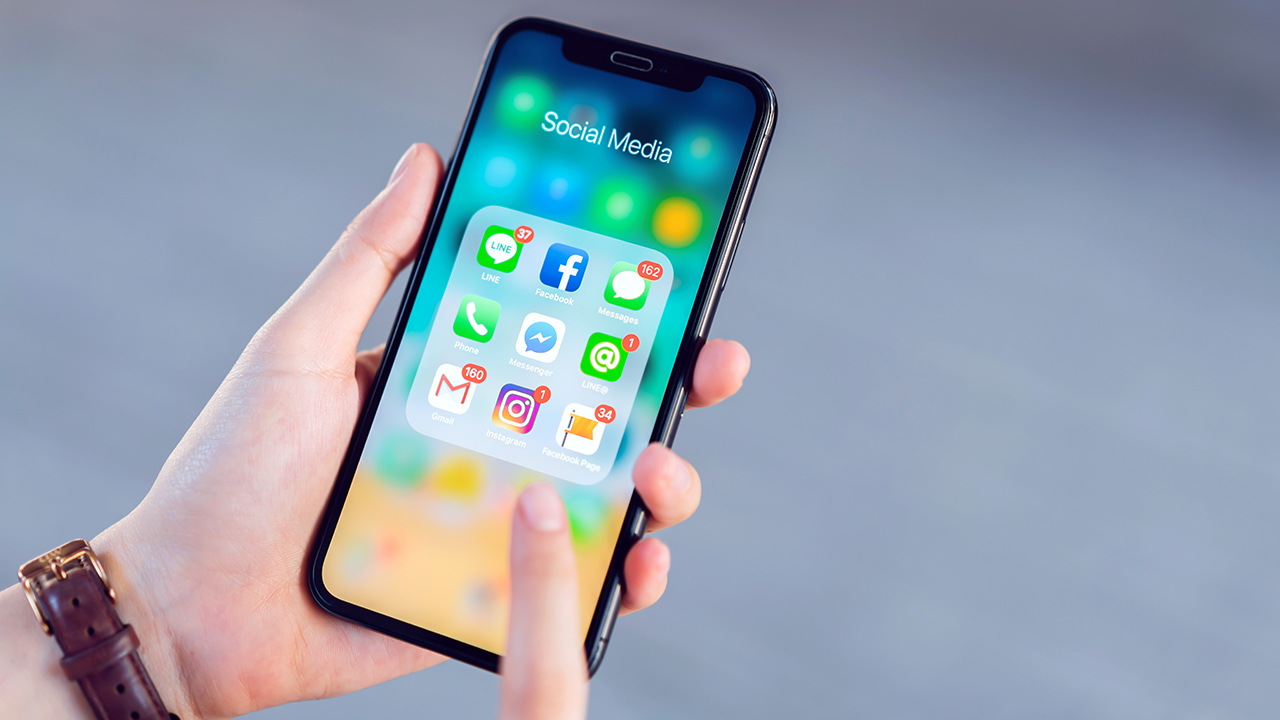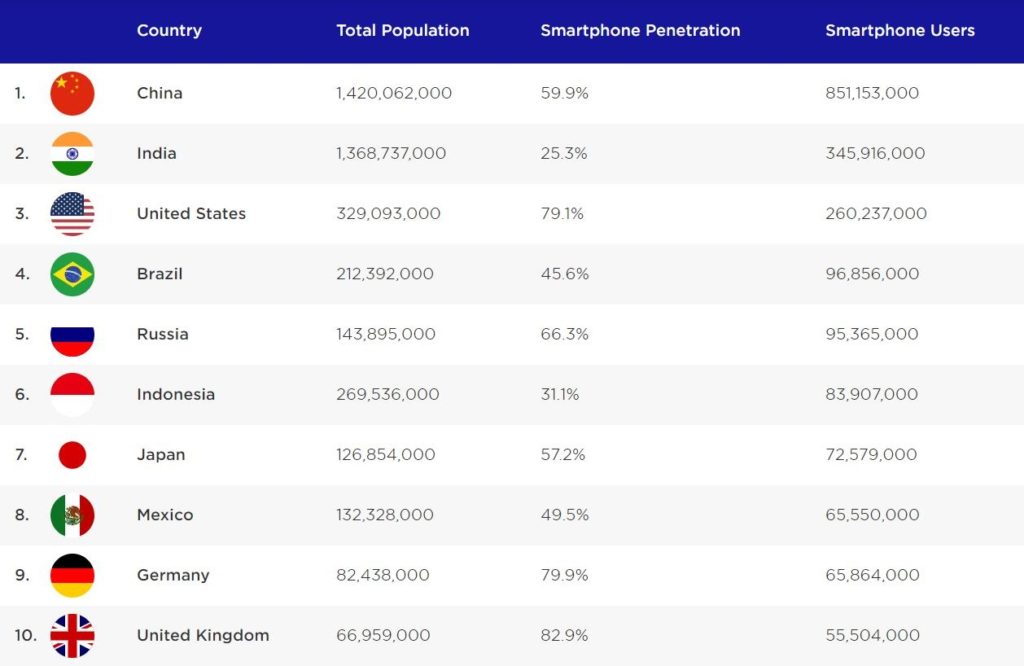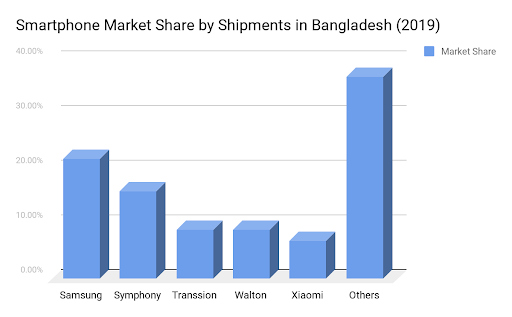GET IN TOUCH
- Please wait...

Once considered a luxury, mobile phones today are essential in every household and one of the most reliable factors for fast communication. People around the world spend an average of 3.25 hours on their phones every day, with the top 20% of smartphone users spending upwards of 4.5 hours in a day.[1] Mobile phones now foster our social connections, communications, entertainment, and finances through different social media apps, enhanced connectivity features, and other software features ingrained within the Operating Software (OS) that increase productivity on the go.
Internet penetration in many developing and underdeveloped countries is largely influenced by the use of and dependence on smartphones for daily work, social media platforms, managing calendars, checking emails, and sometimes for the original purpose i.e. making phone calls. This irreplaceable role of smartphones has made it a very lucrative area for investment throughout the world. Moreover, the whole ecosystem has grown centering on smartphones with emerging companies offering products and services related to smartphones.
The leading global smartphone vendors today are Samsung, Apple, and Huawei. Taken together the three technology companies account for about half of all smartphone shipments worldwide. All three shipped at least 200 million smartphones in 2018, with Samsung leading the way with more than 290 million smartphone unit shipments.[2] The smartphone market has high growth potential with a penetration rate of around 70 percent in highly populated countries like China and India. The revenue of the global smartphone market continued to increase over the last few years, despite stagnating unit sales – due to a growing average selling price of smartphones.[2]

The biggest consumers of smartphones are in the Asia-Pacific region, with over 732 million units bought last year. China accounted for 60 percent of the region’s total market value and 54 percent of market volume – making it the largest contributing country in the global smartphone market. India is the second-largest Asia-Pacific market where more than 161 million smartphones worth over USD 28.5 billion were sold last in 2018.
Like other neighboring countries, smartphones have got nationwide acceptance in Bangladesh and have made Bangladesh the 5th largest mobile market in the Asia Pacific.[3] With the increasing popularity of smartphones, more companies now want to be a part of the smartphone ecosystem to stimulate business growth keeping up with technology.
The smartphone ecosystem encompasses smartphones’ hardware and software platforms, applications running on top of the platform as well as the infrastructural components ensuring connectivity. This ecosystem in Bangladesh can be broken down into the components as follows:
The ecosystem is regulated by the device manufacturers as gatekeepers followed by the service providers, the apps, and content services. One component has an impact on the performance of the others.
For example, Grameenphone’s being one of the most prominent service providers has helped the other component My GP, an app in the ecosystem, to become one of the top 5 apps on the Google Play Store in Bangladesh. Subscribers of GP, who are more in number than that any other telecom operator, started using the My GP app for services like buying data packs, talk-time, and other exclusive offers that could be availed only through the app. Likewise, many other brands are trying to leverage their position in the ecosystem in order to push their products and services.
Samsung, a South Korea-based company, is the market leader in the smartphone industry of Bangladesh.[4] The company’s sales grew 203% YoY (year-over-year)in 2019 helping it capture the top spot for the first time in Bangladesh.[5] New product models and optimized local assembly were the key reasons behind Samsung’s growth. Diversifying the portfolio also helped Samsung as the smartphones dominated their respective price bands. The Galaxy J series operates in the entry-level market with affordable devices built with low-cost hardware whereas the Galaxy A series brings upper mid-range smartphones built with comparatively more expensive materials. The Galaxy S and Note series are the two flagship lineups of Samsung.
Symphony started its journey to become the general people’s local brand. Competitive pricing strategy, an adaptation of innovation, and the largest nationwide distribution of over 17,000 outlets have contributed to the success of the company.[6]
The Chinese firm Transsion has been looking for opportunities to scale up local assembling. In order to increase market share, the company is following a multiple brand strategy with brands like itel, Tecno, and Infinix.
Walton offers locally manufactured smartphones with an adaptation of the features of the best smartphone brands. The company offers industry-level features at an affordable cost taking advantage of local manufacturing and assembling with the subsequent availability of cheaper alternatives.
Xiaomi of China is one of the prominent international players in the smartphone industry of Bangladesh. Consumers appreciate the brand for the perfect combination of affordability and quality it offers. This was reflected in the 165% YoY shipment growth of Xiaomi smartphones to Bangladesh in 2019.[5]

System-on-a-chip vendors: Besides smartphone manufacturers, the chipset providers also play important roles in the smartphone ecosystem of Bangladesh. Chipsets in mobile phones are designed to perform one or a few dedicated functions, mostly with real-life computing constraints. Their CPU performance is important for the daily user experience. People today have become more aware of the different types of GPU (Graphics Processing Unit) chips that come as part of mobile chipsets. These considerations today play significant roles in the decision-making of buyers. Chipsets used by the brands vary across the world. The cost and eventually the target market is hugely influenced by the kind of chipset used.
In this market of chipsets, MediaTek is the leader with a 54% market share, followed by Qualcomm at 15%.[5]
The overall increase in demand for smartphones has created possibilities for local manufacturers to establish profitable businesses. The locally manufactured devices started to enter the ecosystem during the last quarter of 2018 creating new dynamics in the market. Consumers who sought affordability and efficient value delivery started buying locally made handsets. During the first quarter of 2019, the smartphone market in Bangladesh grew 45% year-on-year (YoY) due to the advent of locally manufactured devices.[5]

The volume of locally manufactured devices makes up 41% of Bangladesh’s smartphone market.[7] Prices of locally assembled devices are lower than that of imported ones. Also, the defect ratio of the latest locally manufactured devices has also come down sharply in comparison to the earlier ones.
The government has been making efforts to promote local manufacturing. The local manufacturers can now take advantage of less cumulative tax rates than the imported handsets. Whereas the imported phones have a tax rate of 34%, the locally manufactured ones are imposed a tax rate of 17% (locally assembled) and 1% (locally manufactured). However, the local brands face competition from both affordable Chinese brands and high-value brands. A common challenge in local manufacturing/assembling is the absence of a robust backward linkage. Recently, however, several foreign brands like Oppo and Vivo are planning to continue manufacturing their smartphones in Bangladesh. This will create profitable opportunities for local assembly partners.
The manufacturers in the ecosystem started initiating partnerships with the service providers with the rising demand for mobile internet. 4G services were launched by the telcos in Bangladesh in Quarter 1(Q1) 2018 to upgrade the lower generation users to the 4G network.[4] This worked as a strong catalyst for the smartphone category to maintain its ongoing growth from 2017. Moreover, telco as a channel also doubled its shipments in 2018.[4]

Smartphone manufacturers leverage associated with the service providers in the ecosystem to push their products and generate revenue. This gave rise to the number of co-branded smartphones in the market.
For example, companies place their products in Robishop (an e-commerce platform by the telecom operator Robi Axiata limited) where consumers can buy smartphones and get attached to Robi and Airtel bundle offers. The leading mobile phone operator Grameenphone (GP) with the highest number of subscribers in Bangladesh offers smartphones of Nokia, Walton, Samsung, etc with interesting bundle offers.
With the rising viewership of digital media, service providers are focusing on making content streaming services available to consumers. All three service providers in the ecosystem have content services of their own (Bioscope from Grameenphone, Banglaflix from Banglalink, and Robi TV from Robi). Besides these, other Bangladeshi companies like Bongo, and 3rdBell provide on-demand services to consumers. These services can be accessed through websites, mobile apps, and other partnered platforms.
Besides these apps, ride-sharing services like Uber, Pathao, Shohoz, etc are key components of the ecosystem. The apps made owning smartphones a necessity for a convenient, reasonably priced, and fast lifestyle. Along with consumers, many riders/drivers also started buying smartphones to earn a living through the ride-sharing network. Consequently, other businesses from outside the ecosystem are coming in. Examples of this are restaurants. An increase in the working class population and worsening traffic conditions are paving the way for food delivery apps like Foodpanda, HungryNaki, UberEats, etc.
The mobile phone industry in Bangladesh is evolving fast and there is a rise in cheaper and affordable phones. There is huge potential for new companies to introduce products in this category as these are the kinds of phones consumers seek the most.
It is now easier than ever to buy a phone due to the aggressive expansion of retail outlets, buying options with EMI (Equated Monthly Installments) and online platforms. Hence, manufacturers should think about the product delivery channels and buying experience besides the products and features.
The business environment is becoming more conducive to the growth of new entrants in the Bangladesh market as the government and policymakers are trying to make more collaborative relationships with brands across the globe with events like the Digital Bangladesh Mela 2020 held recently. This may turn Bangladesh into a hub for technology in the future and decrease its dependency on imports from other countries.
The future of smartphones is very likely to be impacted by the introduction of wearable/implant technologies, Virtual Reality (VR), Augmented Reality (AR), etc. The introduction of these technologies will in turn change how brands connect with smartphones, how the components in the ecosystem interact, and eventually the whole ecosystem. So, the existing and new companies should continuously evolve keeping these factors in mind to integrate the mobile experience into every element of the customer journey.
Saim Ahmed Shifat, a Trainee Consultant at LightCastle Partners, has prepared the write-up. For further clarifications, contact here: [email protected].
Our experts can help you solve your unique challenges
Stay up-to-date with our Thought Leadership and Insights